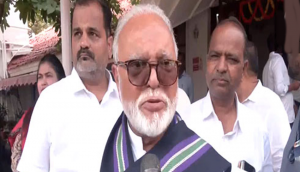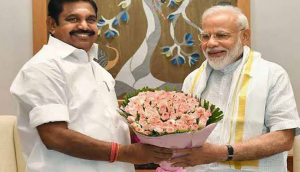Congress-mukt Bharat: BJP inches closer to its goal

The results of the Assembly polls in 4 states and 1 Union Territory have been announced. Mamata Banerjee's TMC and J Jayalalithaa's AIADMK have stormed back to power in West Bengal and Tamil Nadu respectively. Two Congress governments have been dislodged -- by the BJP in Assam and by the Left in Kerala. The only consolation for the grand old party is the Union Territory of Puducherry where it has won with a little help from the DMK.
These results come just a week before Prime Minister Narendra Modi completes 2 years in office. It would, therefore, be tempting to see the results as a referendum on Modi's performance over the last 2 years. However, these elections are not about Modi. The Prime Minister's performance or his politics seem much less of a factor than they were in the other Assembly elections that have taken place since he came to power.
Even in the 2014 Lok Sabha elections, all these states with the exception of Assam withstood the Modi wave. Tamil Nadu and West Bengal overwhelmingly voted in favour of AIADMK and TMC respectively, while in Kerala the rise of Modi ended helping the Congress-led UDF.
The BJP, too, downplayed the Modi model in these 4 states, in what was major departure from other Assembly elections such as Maharashtra, Haryana, Jharkhand, Delhi, Jammu and Kashmir and Bihar.
Even in Assam, where the BJP has won a huge victory, it emphasised more on its state leaders like Sarbananda Sonowal and Himanta Biswa Sarma.
However, the results of these elections would have significant implications for Modi and the larger polity.
More at stake for Amit Shah than Modi
The Modi wave has been on the wane for some time now. Even in Haryana and Maharashtra, which went to the polls barely months after Modi came to power, the BJP's vote share reduced considerably since the Lok Sabha elections. In Bihar and Delhi, the BJP was on the opposite side of a wave.
The victory in Assam would restore some of the faith in Brand Modi that had been eroded because of the debacles in Bihar and Delhi.
The other consequence is that sports minister Sarbananda Sonowal will be heading to Dispur as the Chief Minister. Perhaps this would provide Modi a good opportunity for a Cabinet reshuffle and some mid-term course correction.
More than Modi, these Assembly elections are a referendum for BJP president Amit Shah. As the BJP tries to expand beyond its core areas of influence, the election results would determine how far Shah's Ashwamedha horse has managed to go.
Besides Assam, Shah worked overtime to ensure that the party registers its presence in the other states. The party has made some breakthrough in West Bengal and Kerala. It opened its account for the first time in the latter state.
A victory in Assam and gains in West Bengal would give the party a much needed morale-booster as it gears up for the crucial Uttar Pradesh Assembly elections next year.
Congress Mukt Bharat?
The BJP seems to have moved one step closer to its aim of Congress Mukt Bharat as the grand old party lost two major states - Assam and Kerala. This would be a huge blow to the Congress which has been suffering one defeat after another since the debacle in the Lok Sabha elections.
These are also states where the Congress organisation is stronger and more entrenched than the rest of the country. These defeats are likely to further harm the party's efforts towards a revival.
Now, the only Congress-led governments are in Karnataka, the hill states of Uttarakhand and Himachal Pradesh and 3 states in the North East: Manipur, Meghalaya and Mizoram. Put together these states account for just 42 Lok Sabha seats.
Of course, this is not an indication of the Congress' support. It continues to be the main opposition party in major states like Madhya Pradesh, Rajasthan, Gujarat, Chhattisgarh and Telangana.
But losing state governments in Assam and Kerala will have two major fallouts. First, the party will lose important sources of funds. BJP outspent Congress by a huge margin in the 2014 elections, even though the latter was in power at the Centre and in rich states like Maharashtra, Andhra Pradesh and Haryana. One can only imagine how this imbalance will increase by 2019.
Second, it would put Congress' status as the main anti-BJP party in jeopardy. A possible AAP victory in Punjab next year would be another nail in its coffin. The Congress' next hope would then be a state it hasn't won in over 2 decades - Gujarat, which goes to the polls towards the end of next year.
However, there is some consolation for the Congress - it has won Puducherry and performed respectably in West Bengal and Tamil Nadu. There is a clear lesson for the Congress - that since 2014, it has only performed well in alliance with a regional party. In Bihar it rode piggy-back on the Nitish Kumar-Lalu Prasad alliance. In West Bengal it contested in alliance with the Left and actually emerged as the largest opposition party.
The Congress would have to reconcile to existing not as the natural party of governance in the country, but as some sort of a fulcrum of an anti-BJP alliance at the national level.
Will the Left stage a comeback?
After winning Kerala the Left is likely to emerge as a key player in this national anti-BJP alliance ironically led by the very Congress it has defeated in the state. Of course, the Left would now have to contend with a possible tussle for the chief minister's chair between VS Achuthanandan and Pinarayi Vijayan.
Though not electorally, the Left is already a major ideological challenger to the BJP at the national level. The JNU row and the Hyderabad Central University protests bear testimony to this. And in JNU Students' Union president Kanhaiaya Kumar, the Left has found a good poster boy against right wing politics.
The Left would have to leverage these advantages. There is scope for a national level anti-BJP alliance and CPI(M) General Secretary Sitaram Yechury would need to try and step into the shoes of the late Harkishan Singh Surjeet, the architect of the UPA-1 government.
Of course, Yechury would have face his share of flak within the party for the decision to align with the Congress in West Bengal. Though the Congress hasn't done badly, the results have been disastrous for the Left.
Rise of the regional parties
If there is one thing that the politics of the last 2 years has shown, it is that the real threat to the BJP doesn't come from the Congress, but from regional parties. The BJP has done well wherever it was fighting against Congress governments, such as in Haryana and Maharashtra. But when it took on regional parties - Arvind Kejriwal's Aam Aadmi Party in Delhi and the Nitish Kumar-led alliance in Bihar - it suffered humiliating defeats.
This phenomenon is likely to get strengthened in this election, especially with the BJP winning Assam, Mamata winning West Bengal, Left winning Kerala and AIADMK winning Tamil Nadu.
This would mean that BJP's organisational strength, Modi's charisma and even the Hindutva card, come to nought against strong parties and leaders that represent regional aspirations.
The BJP would be happy to see the AIADMK victory in Tamil Nadu over the DMK-Congress alliance. Moreover, Modi is known to share a good equation with Jayalalithaa.
The BJP also wouldn't mind Mamata Banerjee returning to power and keeping the Left-Congress alliance out. Moreover, the aggressive pro-minority politics of Mamata could potentially create space for the rise of BJP in a few years time. But the flipside is because of the same factor that Mamata is unlikely to ever be part of a BJP-led alliance at the Centre. So in the end, the party will have to contend with another adversary at the national level, that too a rather voluble one.
The victory of regional parties and the weakening of the Congress is also likely to strengthen players like Nitish Kumar and Arvind Kejriwal, both of whom would want to emerge as the main challenger to Modi by 2019.
Modi might have to deal with a new and more unpredictable set of enemies in the months to come.
First published: 19 May 2016, 12:51 IST






![BJP's Kapil Mishra recreates Shankar Mahadevan’s ‘Breathless’ song to highlight Delhi pollution [WATCH] BJP's Kapil Mishra recreates Shankar Mahadevan’s ‘Breathless’ song to highlight Delhi pollution [WATCH]](https://images.catchnews.com/upload/2022/11/03/kapil-mishra_240884_300x172.png)

![Anupam Kher shares pictures of his toned body on 67th birthday [MUST SEE] Anupam Kher shares pictures of his toned body on 67th birthday [MUST SEE]](https://images.catchnews.com/upload/2022/03/07/Anupam_kher_231145_300x172.jpg)






